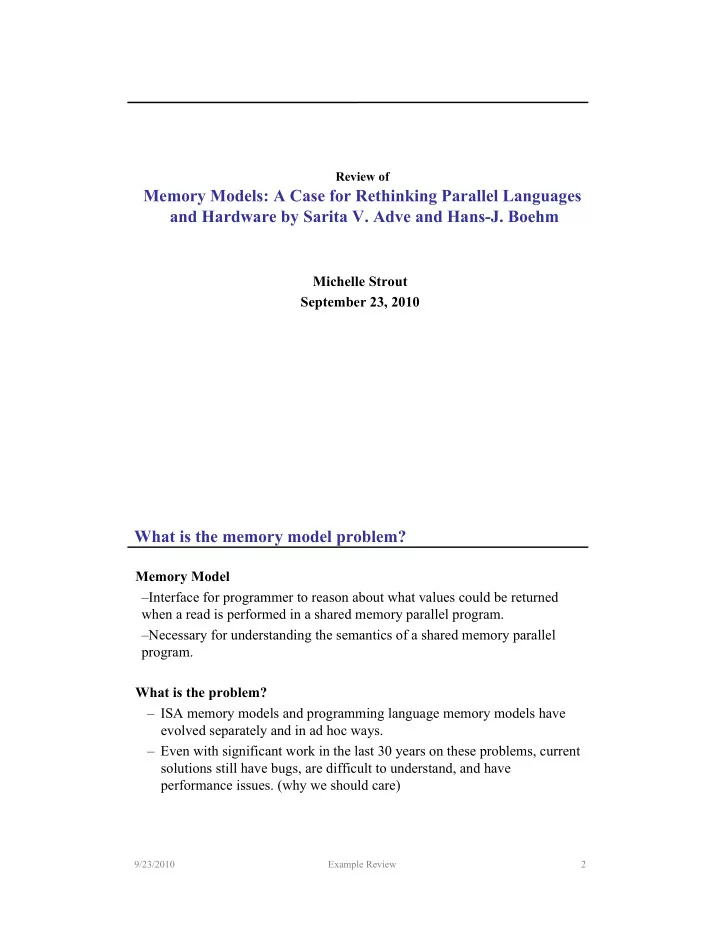

Review of Memory Models: A Case for Rethinking Parallel Languages and Hardware by Sarita V. Adve and Hans-J. Boehm Michelle Strout September 23, 2010 What is the memory model problem? Memory Model – Interface for programmer to reason about what values could be returned when a read is performed in a shared memory parallel program. – Necessary for understanding the semantics of a shared memory parallel program. What is the problem? – ISA memory models and programming language memory models have evolved separately and in ad hoc ways. – Even with significant work in the last 30 years on these problems, current solutions still have bugs, are difficult to understand, and have performance issues. (why we should care) 9/23/2010 Example Review 2
How should we evaluate memory models? Programmability – Easy to explain and teach to undergraduates. – Should enforce no data races. – Should enable the expression of "important parallel algorithms and patterns” – Can multiple programming languages implement the memory model. Portable Performance – After all, that is one of the main reasons we do parallel computing in the first place. – Is the model reasonably supported (efficient and inexpensive) by various computer architecture paradigms 9/23/2010 Example Review 3 Quick Review of Terminology Sequential consistency as a memory model – Possible parallel results can be determined by trying all possible sequential interleavings between instructions in threads. Instructions in a single thread must occur in same order in interleaving as they do in the thread. Data Race – When two instructions that could be executed in parallel read or write the same memory location and at least one of the instructions is a write 9/23/2010 Example Review 4
Detailed Examples of the Problem Figure 1, Dekker’s algorithm Figure 2, non-determinism in the hardware Figure 4a and 4b, speculation combined with control and data dependences – They say 4a does not have a data race. Figure 5, do we allow individual program optimizations? 9/23/2010 Example Review 5 Current Solutions and Remaining Problems Ada – Pro: high-level programming model with support for shared memory parallel programming – Con: “did not fully formalize the notion of well-synchronized” Java – Pro: threads in the language – Con: must deal with data races due to safety guarantees of the language – Con: in memory model a “future can determine whether the current access is legal” C/C++ and POSIX threads – Pro: simpler than Java memory model, because can leave data races undefined – Con: Atomic keyword can break sequential consistency Data-race free – Single-thread program optimizations must still be modified – Does not deal with data races – May not have efficient sequential consistency support in HW – Does not "eliminate atomicity violations or non-deterministic behavior" 9/23/2010 Example Review 6
Author Conclusions and Future Research The shared memory programming model is important and should be supported with good memory models – Hardware already supports it (e.g., cache coherence) – Can pass references to complex data structures, which is much more efficient than copying – Incremental parallelization is easier – Do not have to explicitly distribute data structures. Memory model development should be more disciplined – Should move away from the test case only based development – “disciplined shared-memory models” System architecture and programming languages should enforce no data races Need SW/HW co-design to successfully evolve and/or reinvent memory models 9/23/2010 Example Review 7 My Future Research Questions Composition of programming models and memory models – Do parallel programming models that we want to compose need to have the same underlying memory model? – Can we develop memory models so they are composable? Implementation details surrounding shared memory parallel programming – Examples include synchronization constructs, atomic, shared, and volatile keywords. – Is this the way we should be expressing these implementation details? – Can we make implementation details such as these more orthogonal to the algorithm specification? 9/23/2010 Example Review 8
Recommend
More recommend